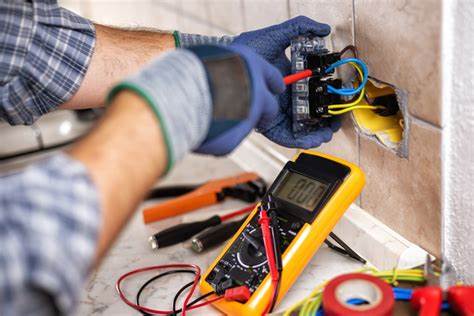When you receive an electrical defect notice, it’s crucial to respond appropriately and ensure that any issues are promptly corrected. This involves understanding the problems, seeking professional assistance, and pinpointing preventive measures for the future. Consider the following best practices.
The first step is recognizing the seriousness of an Electrical Defect Notice. This notice signifies the danger lurking in your electrical installation and must not be omitted. It’s essential to get in touch with a professional electrician who can assess the situation and tackle the problem piece by piece.
Not every concern you encounter will be straightforward. Some will need careful interpretation and that’s where a level 2 electrician comes in. They are specifically trained and qualified to handle complicated electrical matters. To know more about this, check this informative post about avoiding electrical defect notices.
Last but not least, ensuring routine electrical maintenance is vital. It not only helps in fixing issues before they become precarious but also plays a crucial role in preventing any future occurrence of electrical defect notices. Invest in professional electrical inspections regularly to safeguard your property and its occupants.
Receiving an Electrical Defect Notice
When you receive an electrical defect notice, you may feel overwhelmed. You need to understand its implications and how to respond adequately. If not addressed promptly, it can increase the risk of electrical accidents at home or your workplace.
A defect notice often comes from either your electrical inspector or the utility company, warning of a threat in your electrical system. Timely response to such can significantly cut down potential hazards, specifically electrical fires.
| Issue Indicated | Immediate Response | Long-term Solution |
| Damaged Wiring | Contact a Licensed Electrician | Scheduled Electrical Maintenance |
| Inadequate Grounding | Consult with an Electrician | Comprehensive Electrical Upgrade |
| Obsolete Circuit Breakers | Emergency Electrician Callout | Circuit Breaker Replacement |
| *note – This is a general guidance, consult with a professional for specific issues. |
The table above outlines some common problems that might lead to a defect notice along with initial and long-term solutions. A proper reaction involves hiring an electrician immediately while strategizing on maintenance routines.
Note that adhering to established guidelines and recommendations when dealing with these defects can reduce the chance of electrical fires by up to 75%.
Involving Professional Electrical Assistance
Professional electrical assistance is essential when addressing an electrical defect notice. Often, these notices indicate underlying issues requiring expert attention.
Electrical contractors trained in identifying and rectifying faults can prevent devastating incidents. Importantly, these professionals ensure full compliance with safety standards.
- Quick response: You must respond promptly to a defect notice. Around 10% of industrial downtime is due to electricity system failures.
- Safety assured: Certified electricians adhere strictly to safety regulations, minimizing risks associated with malfunctions.
- Detailed inspection: This helps uncover hidden hazards, safeguarding assets from extensive damage.
Neglecting defect notices can lead to severe consequences, including electrical fires or shocks. Responding promptly assures safety and reduces downtime.
You must strive for regular inspections and maintenance. This preventive approach can save costs and circumvent potential disasters.
Addressing Identified Electrical Defects
Once you receive an electrical defect notice, it’s crucial to act promptly. The safety of your home or workplace depends on a well-maintained and functioning electrical system.
The appropriate response steps to take deal directly with the issues mentioned in the defect notice. Understanding these measures could potentially save lives and property.
- Determine the Issue: Inspect the concerned area carefully, noting any visible irregularities.
- Gather Information: Seek detailed explanation regarding the notice from relevant parties, such as your local regulatory authorities.
- Hire a Licensed Electrician: Ensure to hire a qualified professional for the job to guarantee quality workmanship and safety compliance.
As soon as you have gathered sufficient information, get in touch with a licensed electrician. Experts can help determine the extent of the problem and devise effective solutions.
Avoid temporary fixes or tinkering with electrical systems if you lack necessary training, as it can aggravate problems leading to more severe consequences down the line.
Your primary focus should be comprehensive defect rectification, ensuring all issues are thoroughly addressed to prevent further defects and potential fire hazards. Therefore, involve experienced professionals from beginning till end.
Resolving the Electrical Problem
The first step in addressing an electrical defect notice is understanding the issue thoroughly. Begin by reviewing the defect notice, which typically outlines the defect and safety concerns associated with it. Ensure you comprehend every detail to guarantee a safe and adequate response.
Engage a Licensed Electrician
Hire a licensed electrician immediately. These experts specialize in troubleshooting electrical problems, ensuring effective solutions aligned to safety standards. Your selection of professionals should be primarily based on qualification, experience, and reputation.
Organize Proper Documentation
Maintain documents related to your electrical systems, inspections, and repairs. This documentation provides historical data, useful in identifying recurring issues, tracking repairs effectiveness or forming resolution strategies.
Perform Regular Inspections
Active maintenance regime reduces electrical defects. Regular inspections can promptly detect potential hazards before they evolve into substantive issues. Remember that prevention is often the most effective measure against electrical defects.
Safety First!
Resolving an electrical defect notice isn’t just about complying with authorities or availing your property of functional electricity. Fundamentally, it’s about safety. According to studies, electrical defects account for approximately 40% of fire-related incidents in commercial properties. Prioritize the safety of others before anything else.
Non-Compliance and Potential Consequences
Ignoring an electrical defect notice can lead to severe repercussions. It’s not just about fines, the aftermath can pose a significant safety hazard. Preserving the safety of one’s environment should always be paramount.
- Mandatory fines: Non-compliant individuals may face substantial penalties imposed by state or local authorities.
- Safety Hazards: Faulty installations, worn-out wiring, or improper earthing can lead to fires, explosions, or electric shocks.
- Damage to Property: An electrical malfunction is a potential disaster that could damage costly appliances and property.
- Legal Liability: If non-compliance leads to accidents, you may face legal proceedings for negligence.
The intent is not to alarm but educate on the importance of adhering to safety notices. An indication from research states – Approximately 30% of electrical-related incidents could have been prevented with proper maintenance and repairs. This statistic alone should encourage prompt attention to defect notices.
Your robust compliance in response doesn’t just prevent financial implications; it also safeguards you, your family, and your property.
You’re not alone in this endeavor; numerous professionals are available to help rectify these defects. Their expertise ensures safe, compliant solutions while providing peace of mind for you and your loved ones.
Prevention Through Regular Inspections
Inspections can be a key element to safeguard your property from potential electrical hazards. Consistent inspections ensure the maintenance of circuits, appliances, and other electrical systems.
Reducing Electrical Hazards
Did you know that regular electrical inspections decrease the likelihood of severe electrical threats by 50%? Such inspections not only protect your property but also save lives.
Obligation Towards Safety
As a conscious homeowner, your duty extends beyond avoiding electrical accidents. It includes ensuring an electricity-safe environment for everyone living in your premises.
Frequent Inspection Benefits
Aside from mitigating risk, consistent inspections guarantee a long-lasting and efficient performance of electric systems. It’s an investment that yields long-term benefits.
Hiring Qualified Electricians
Ensure to employ licensed professionals for your electrical inspection needs. Their expertise guarantees detailed examination and reliable suggestions for repairs or revisions if needed.
Educate and Inform
Equally important as inspections is educating everyone in your household about electrical safety. It significantly minimizes risks associated with mishandling of electronic devices or systems.
Future Electrical Defect Prevention
Proper maintenance of electrical systems is critical for preventing future defects. This includes regular testing and inspection by professionals to spot any potential problems early on.
Besides maintaining your system, it’s equally important to respond swiftly to any notifications about electrical defects. According to research, properties with a history of fast response to electrical defect notices have about 55% fewer electrical incidents than those with slower response times.
- Regular inspections: Ensure your electrical system is checked regularly by a qualified professional. This can spot potential defects before they turn into major problems.
- Swift response: When you receive an electrical defect notice, act quickly. The faster you address the problem, the less likely it may lead to further safety risks or costly repairs.
- Maintenance documentation: Keeping detailed records of all repairs and maintenance could little down susceptibilities for defect occurrences. They’re extremely useful for tracing past works and isolating issues.
Your approach to responding to defect notices should be systematic rather than random fix-ups. It encompasses everything from inspection and testing procedures to your reaction toward defect notices.
In addition, identifying the root causes of the defects will help ensure that they do not recur in the future. So, consider hiring experienced professionals who can provide expert advice on how best to secure your property’s electrical infrastructure.
Handling Electrical Notices
Learn how to best respond to an electrical defect notice quickly, efficiently, and correctly with safety as a priority to prevent further risks. For more detailed insights, visit their website.









































































